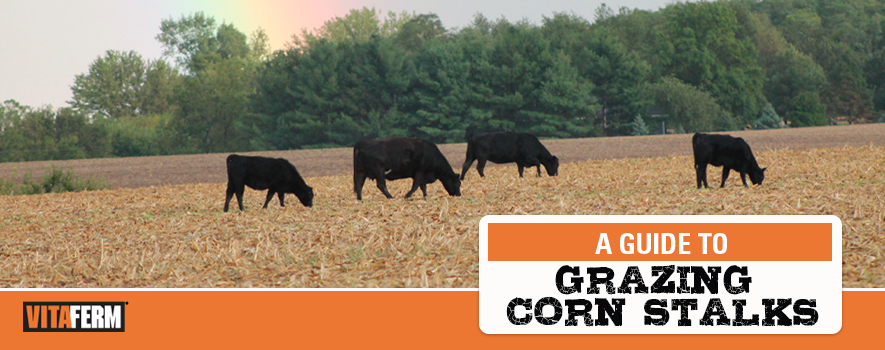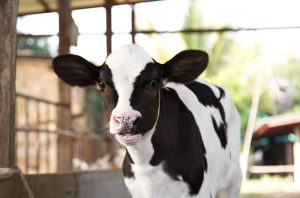
If you’ve driven throughout the rural Midwest in the last week or two, you’ve likely noticed a significant difference in the landscape. Where tall corn fields once stood, you can now see for miles, as harvest is in full swing and only the stalks remain.
“In the upper Midwest and in the Plains, there is an abundant supply, and corn stalks are often the most underutilized feed resource we have. They can absolutely be part of a grazing plan and expand the grazing season. Every day on corn stalks is probably one less day of feeding hay,” said Dan Shike, Ph.D. Associate Professor of Animal Science at the University of Illinois.
Cattle are selective grazers, according to Shike, and will eat the most nutritious, most digestible corn stalk residue first, starting with the grain, moving to the husks, then the leaves, cobs and then the stalks.
We recently visited with Shike and asked him to discuss some considerations when using corn stalks as part of a grazing plan.
- How long can producers expect to graze their cattle on corn stalks?
There are several factors and considerations to make. Weather has an impact on how successful your grazing plan is. The sooner you start, the more nutrient value you will have as the residue sets out there in the field. Weathering losses from rain, sun and wind will also reduce the amount of residue that is available. If we are talking about good corn ground – 200 bushel per acre ground and you have a moderate-sized cow – you can probably get 60 days of grazing if you go one cow per acre. Larger cows will obviously eat more. If we get into a time frame where there’s more rain and mud, and we get into significant trampling losses, then that would be reduced quite a bit. If we don’t start grazing until November or December, we could have some snow coverage and ice that would limit and reduce how much we have to graze.
One of the benefits, depending on the region you are in, is we still have some cool-season grasses that are greening up. If we can be on corn stalks now and resting some pastures and get some good fall regrowth, we can stockpile that fescue and come back and graze some more when we come off the corn stalks. That’s kind of an added benefit if we can get into some early harvest corn fields and be out there grazing mid-September through the first of November, that’s a great time to rest those cool-season pastures.
- Are there concerns for overconsumption in areas with downed corn?
If you are grazing downed corn fields, you need to be careful. On one hand, there’s a lot of feed out there; on the other hand, you have to take some precautions. Some producers utilize strip grazing. Strip grazing would be a good idea if there is a lot of grain out there. If there is an 80-acre field and you put 80 cows out there, they are going to go over the whole field and eat only grain the first few days. You can have significant issues there.
Turn them out full and limit the area they have access to by moving the strip fencing. There are reasons to consider that even if there isn’t a lot of grain. They will always selectively graze, looking for grain, eating those husks and leaves and trample everything in. If you are planning on being out there for 45 to 60 days and the second week you get at 3-inch rain, they’ll mud the whole thing up. If you only have them in part of it, at least the other part didn’t get trampled in, then after a couple days of drying out, you can move that fence to a new section and you didn’t lose all that.
If you know in the next three to four days, there is going to be a significant weather event where it is going to rain a lot, the best thing to do is have somewhere to pull those cows in to a lot so you don’t lose that grazing area, or just know you are going to muck up that particular area.
- Should you worry about bloat or any other sickness when turning out on corn stalks?
Whenever there is a diet change, you want to keep an eye on your cattle. But you want to turn them out full, you don’t want to have them locked up and emptied out and turned out to a new pasture or a corn field; that isn’t a good management practice. Typically, there shouldn’t be any big concerns. The harvest efficiency of this equipment is pretty good. If you have grain spill, you probably would have cleaned that up anyway.
- What kind of supplementation do we need to provide when on corn stalks?
The thing you need to take into consideration is what stage of production is that cow in. If you are a spring calving herd and you aren’t going to calve until March or April, those cows are in mid-gestation, and those cows’ requirements are pretty low on corn stalks, and at least initially you probably don’t need to supplement. The longer you are out there, you probably want to think about supplementing.
If you happen to be calving earlier, like January or February, and you are grazing in November or December, their requirements in late gestation obviously are greater, and need some protein supplementation. You might want to utilize a lick tub or some distillers to supplement the protein.
Now if you have fall-pairs out there, you’re calving in September, and you’re going out to stalks with a baby calf at side, you definitely need to have some protein and some energy supplementation as well.
- Why wouldn’t I want to utilize corn stalks as a feed source?
The biggest reason there isn’t a great adoption of grazing corn fields is a lot of integrated operations are focused on grain production and worried about subsequent crop yield caused by compaction. We’ve actually conducted research at the University of Illinois that shows the impact of fall grazing is pretty minimal to future yields.
The beauty of the upper Midwest winters is the freezing and thawing through the winter helps mitigate the compaction that may have occurred and as long you aren’t out there through real extended heavy rain and adverse weather, there are very minimal impacts at all. Interestingly, there is some research that shows no impact.
Although corn stalks are an abundant feed resource throughout the Midwest and Plains states, like Shike expressed, they do require some supplementation. VitaFerm® offers options to producers looking for supplemental protein in various reproductive stages. The VitaFerm® Concept•Aid® Protein Tub, VitaFerm® 30-13% Protein Tub™ and VitaFerm Conserve® Protein Tub are all 200-pound cooked tubs with additional protein that include Amaferm®, a precision prebiotic designed to increase intake, digestion and absorption of feedstuffs.


